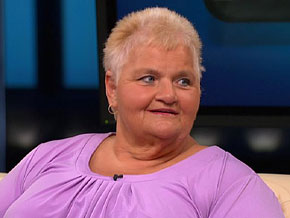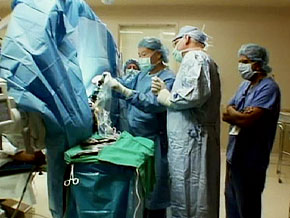Radical Weight Loss Surgery

Like millions of men and women across the country, Carol has been struggling with her weight for decades. At 5'2'' and 287 pounds, this 60-year-old woman is one of the 15 million Americans considered morbidly obese.
Carol says she weighed almost 490 pounds at her heaviest. Since then, she's tried dieting, exercising, stomach stapling and gastric bypass surgery to reach a healthy weight...but nothing has worked. "I've always known in my heart that there had to be something else," she says.
What if there was a medical solution that could put an end to Carol's yo-yo dieting, food cravings and calorie counting? Well, there is.
Carol says she weighed almost 490 pounds at her heaviest. Since then, she's tried dieting, exercising, stomach stapling and gastric bypass surgery to reach a healthy weight...but nothing has worked. "I've always known in my heart that there had to be something else," she says.
What if there was a medical solution that could put an end to Carol's yo-yo dieting, food cravings and calorie counting? Well, there is.

Doctors at West Virginia University Hospital say they may have cracked the weight loss code.
The groundbreaking procedure—deep brain stimulation surgery—has been used to treat Parkinson's symptoms for more than a decade, but now obese patients are signing up.
On February 3, 2009, Carol became the second person in the United States to have this experimental brain surgery to help control her weight. "I've tried everything else," she says. "I really believe that it's got something to do with the brain."
The three-hour procedure, which is still in trials, is performed while the patient is fully awake. "The brain feels no pain," Dr. Oz says.
The groundbreaking procedure—deep brain stimulation surgery—has been used to treat Parkinson's symptoms for more than a decade, but now obese patients are signing up.
On February 3, 2009, Carol became the second person in the United States to have this experimental brain surgery to help control her weight. "I've tried everything else," she says. "I really believe that it's got something to do with the brain."
The three-hour procedure, which is still in trials, is performed while the patient is fully awake. "The brain feels no pain," Dr. Oz says.

To reach the area of the brain that controls hunger, neurosurgeons insert electric probes about 4 inches into Carol's brain. "If you put a probe in there and put electricity through it, you can stimulate that part of the brain so you no longer get hungry," Dr. Oz says.
Watch Dr. Oz explain this experimental weight loss surgery.
After the brain probes are in place, doctors also implant regulating devices, which are similar to pacemakers, into Carol's chest. These monitor the electrical currents that control Carol's food cravings and feelings of satisfaction.
"You turn these on when you're ready to turn it on, after the wounds have healed," Dr. Oz says. "Then, you can begin to stimulate [the brain]."
Watch Dr. Oz explain this experimental weight loss surgery.
After the brain probes are in place, doctors also implant regulating devices, which are similar to pacemakers, into Carol's chest. These monitor the electrical currents that control Carol's food cravings and feelings of satisfaction.
"You turn these on when you're ready to turn it on, after the wounds have healed," Dr. Oz says. "Then, you can begin to stimulate [the brain]."

Since Carol's electrical currents were turned on about nine weeks ago, she says she's lost 11.5 pounds.
"I can have the same things that I had before, but my diet's totally changed," she says. "I don't want all the foods that I wanted before, and I do go to the gym now."
Carol says she now reaches for fruit instead of candy bars when she opens the refrigerator. "I just don't want it. I don't have the cravings for it," she says. "It's changed my eating habits totally to healthier food. I make better choices now, and I have more energy."
Since her surgery, Carol says she's able to do things she hasn't done in years...like mow the grass!
"I can have the same things that I had before, but my diet's totally changed," she says. "I don't want all the foods that I wanted before, and I do go to the gym now."
Carol says she now reaches for fruit instead of candy bars when she opens the refrigerator. "I just don't want it. I don't have the cravings for it," she says. "It's changed my eating habits totally to healthier food. I make better choices now, and I have more energy."
Since her surgery, Carol says she's able to do things she hasn't done in years...like mow the grass!

Carol's surgeon, Dr. Don Whiting, says the goal of this operation is to help the brain's eating center find a healthier balance.
"Everybody knows people who have had heart pacemakers to have their heart work better," he says. "This is like a brain pacemaker that we hope changes the electric signals and the chemicals into the brain to give you a better metabolism."
Before this procedure becomes widely available, Dr. Whiting says he and his colleagues have to prove it's effective and safe. Then, he says, doctors may consider deep brain stimulation surgery when all else fails. "It would probably start out after bypass surgery, but it's a whole different approach," he says. "We're actually going to the control center, we think, to adjust things in a different way."
"Everybody knows people who have had heart pacemakers to have their heart work better," he says. "This is like a brain pacemaker that we hope changes the electric signals and the chemicals into the brain to give you a better metabolism."
Before this procedure becomes widely available, Dr. Whiting says he and his colleagues have to prove it's effective and safe. Then, he says, doctors may consider deep brain stimulation surgery when all else fails. "It would probably start out after bypass surgery, but it's a whole different approach," he says. "We're actually going to the control center, we think, to adjust things in a different way."
Keep Reading
Deadly Superbug and Bacteria
How flesh-eating bacteria can ravage the body. Plus, Dr. Oz's warning about MRSA...a growing epidemic.
How flesh-eating bacteria can ravage the body. Plus, Dr. Oz's warning about MRSA...a growing epidemic.
MRSA Safety Tips
Want to protect yourself from dangerous bacteria and infection? Simple ways to stay healthy at the hospital or health club.
Want to protect yourself from dangerous bacteria and infection? Simple ways to stay healthy at the hospital or health club.
More on this topic









